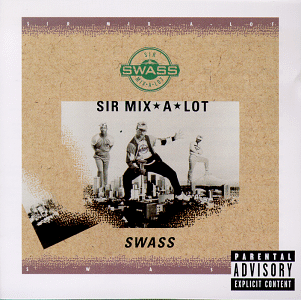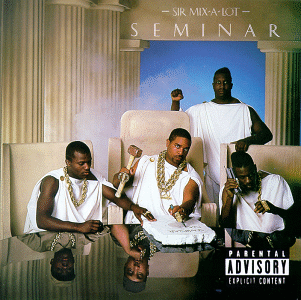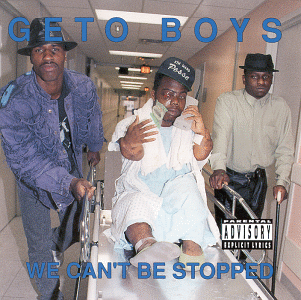the rasx context
Sir Mix-A-Lot: A Three-Album View
EDITOR’S NOTE: This article was previously published in FreeStyle Mazagine. about seven years ago. I’m bringing it back. Selected links on this page lead to highly recommended CDs sold by Amazon.com.
How many swimming pools are in Seattle? Does Sir Mix-A-Lot own one? If he does and if he gives a pool party, would he decorate it with professional strippers (with much back)? Who cares! January’s issue of The Source Magazine proclaims this man, who may or may not be pool-less, one of the artists “who made a difference” in 1992 (with or without mercury-tipped bullets).
The release of his latest album Mack Daddy and his appearance on Arsenio Hall in front of a colossal boody (related to booty: the posterior, heterosexual treasures of a woman) tells the world that he is not without new ideas. The following statement is not sarcastic: Sir Mix-A-Lot is reportedly the first male rap artist to use the word “sexist” on record. Sir Mix-A-Lot is so funkyfresh right about now that “funky fresh” may be slang too old to describe him.
 For those who no longer find KRS1 ingenious, now that he is suffering from an accent transplant (dig his dance-hall, Shabba style on his LP Sex & Violence), for those who shake their heads when they read about Chuck D hastily scribbling rhyming syllables down on a note book just before going into the studio (Greene Street studios, 10:00 P.M., SoHo, 1990), or for those who yawn over some fragment of N.W.A reciting the A.B.C.’s of ballistic hardware and ho-sex on top of a sacred P-funk burial ground (don’t dig Dre’s The Chronic, pronounced cra-zz-onic for those living members of the Cuzz gang with sherm to smoke and a pool party to go to), there is relief to know that not all successful ($$$!) rap artists flat line their brainwaves and entomb the muse once they earn enough cash to eat regularly.
For those who no longer find KRS1 ingenious, now that he is suffering from an accent transplant (dig his dance-hall, Shabba style on his LP Sex & Violence), for those who shake their heads when they read about Chuck D hastily scribbling rhyming syllables down on a note book just before going into the studio (Greene Street studios, 10:00 P.M., SoHo, 1990), or for those who yawn over some fragment of N.W.A reciting the A.B.C.’s of ballistic hardware and ho-sex on top of a sacred P-funk burial ground (don’t dig Dre’s The Chronic, pronounced cra-zz-onic for those living members of the Cuzz gang with sherm to smoke and a pool party to go to), there is relief to know that not all successful ($$$!) rap artists flat line their brainwaves and entomb the muse once they earn enough cash to eat regularly.
The sincerely admiring rap critic from the vanilla suburbs should not feel condescending when calling this homey a rap artist. Sir Mix-A-Lot has been working hard for years producing works worthy of the term “artistic.” The task here is to look at three of his albums to really see what his art is all about and maybe someday, without a Pat Boone, it won’t be so difficult to identify specific rap techniques and the schools from which they come. I’m talkin’ real textbook, mastermind, intellectual shit. Can we get to that? Let’s:
1988 saw Sir Mix-A-Lot’s Swass LP. The work was bold in nerve in not only trying to get a new slang word (the word “swass”) installed in the inner-city Diaspora, but also the introductory cut “Buttermilk Biscuits (Keep on Square Dancing)” was very unique, with that Southern drawl. Perhaps this “square-dance rap” style was meant to catch on without a name (like Humpty-Hump) being connected to the voice characterization. That didn’t happen but was still a clear attempt to establish Sir Mix-A-Lot as one that will try something crazy just for the funk of it.
Sir Mix-A-Lot shows pride in the process as well as the excess ($$$!!) that comes with being a rapper with studio time. Some of these brothers be working hard with a lot of high-tech precision equipment and they want the whole world to know it.
“Possé on Broadway” is even more crazy, one of the funniest and funkiest works on the rap scene. The id of the American African, male, young, and wealthy (or, at least, on credit) was celebrated on the cut as he and his dudes roam the streets attracting women of the “Mix-A-Lot set” in a limo like a rolling stone gathering much swass: “five fellas and twenty-two freaks!” The treated Godzilla sample, used as a percussive element, highlights the enormity and harmlessness of the high-dollar funnin’. Speaking of percussion, Mix-A-Lot is quite fond of that cow-bell type of inter-beat.
Characteristic of the so-called “old school” style (what Mix-A-Lot refers to as “B-Boyism” hinting at a Run-DMC thang), Mix-A-Lot composes every sound for drum-like rhythmic presentation, on a silent background. His cut “Gold” (not to be confused with the more sample-rich “Gold” of GrandMaster Flash and The Furious Five’s On the Strength—this LP also came out in ‘88) is perfect example of his style: full of beat, efficient and minimalist. Sir Mix-A-Lot effectively has a four-track mind. This is a far cry from the sixteen to thirty-two track walls of sound constructed by Public Enemy, specifically The Bomb Squad, on their 1988 release It Takes a Nation of Millions to Hold Us Back. The negative side of building a wall of sound (for those not as down as the Squad) is that it may dwarf the vocals and get monotonous.
Swass’ “Bremelo” took the rhyme scheme and cadence of L.L. Cool J’s 1985 hit “I Can’t Live without My Radio.” Characterizing his voice like L.L.’s as well, this allowed him to concentrate on the lyrics which are very funny (if one is not sensitive to criticizing people 20% or more above their ideal body weight; e.g. “…to be blunt, she was fat and ready for combat”). The occasional elephant sample went a long way to accent the pro-low-calorie humor.
Mix-A-Lot on his 1989 Seminar LP continues to have humorous lyrics, avoids the walls of sound—working over silence—, and keeps control over the intended jam. The graphical layout of the album seems to set in stone Mix-A-Lot’s artistic control, what with the display-sized type, “All Songs Written, Composed, Programmed, Performed, Produced And Engineered By Sir Mix-A-Lot.” Like the posed but candid studio shot on EPMD’s Strictly Business LP (yet another 1988 release!), Sir Mix-A-Lot shows pride in the process as well as the excess ($$$!!) that comes with being a rapper with studio time. Some of these brothers be working hard with a lot of high-tech precision equipment and they want the whole world to know it.
 “Seminar” and “Beepers” show an expanded interest in samples as percussion, as well as elements to interact with the lyric. “Beepers” would definitely be nothing without that Prince, “Kiss” guitar twang and the ‘sky pager’ compressed electronic voice. “National Anthem,” filled with luke-hot political rhyming is a departure from the picaresque, ‘bitches and money’ humor characteristic of Mix-A-Lot. This departure is not as awkward as Run-DMC’s “Proud to Be Black” (‘86: Raising Hell) attempt at consciousness since Mix still maintains his sense of humor in the form of sarcasm framing his jam with an awful baritone rendition of that drinking song by Francis Scott Key.
“Seminar” and “Beepers” show an expanded interest in samples as percussion, as well as elements to interact with the lyric. “Beepers” would definitely be nothing without that Prince, “Kiss” guitar twang and the ‘sky pager’ compressed electronic voice. “National Anthem,” filled with luke-hot political rhyming is a departure from the picaresque, ‘bitches and money’ humor characteristic of Mix-A-Lot. This departure is not as awkward as Run-DMC’s “Proud to Be Black” (‘86: Raising Hell) attempt at consciousness since Mix still maintains his sense of humor in the form of sarcasm framing his jam with an awful baritone rendition of that drinking song by Francis Scott Key.
If Mix-A-Lot can be accused of bragging about certain material objects that somehow sexually arouse women, works like “My Houptie” proves that such genital magnets of hard-core iron maidens were not always in his life. His houptie (or personal car) is described as “running on leaded” and a “pot hole crusher.” Alas, poverty is romantic as a memory—and the memory is immediately nullified with “Something about My Benzo.” This cut blatantly describes what shows of wealth will do for a brother (“A Rappers Reputation” on Mack Daddy is back to this same topic; see below). The line “use me, I use you and that’s how the story goes” leaves no sympathy for the ho-sex stylist—only jealousy from the horny.
Although Seminar adds little to the spectrum of Mix-A-Lot styles used in Swass and serves as a sampling ground for the subsequent come-back LP Mack Daddy (e.g. “L.A. face with Oakland boody” and “Little in the middle but she got much back” are recycled), the album still has fresh samples such as that featured in the “The (Peek-A-Boo) Game.” This song also adds something new to the Mix style with its psychological profile behind the sexual behavior of certain women and their “game.”
1992’s Mack Daddy finds Sir Mix-A-Lot hooked up with Def American and his Nastymix record company with the beloved Mix-A-Lot studios all under the Rhyme Cartel. “The Boss is Back” clearly outlines this transition and that he is still running things, claiming ownership of Rhyme Cartel (he’s got the motherfucking papers on the motherfucking table), cursing all of his former materialistic associates who abandoned him when poverty and obscurity was a vague possibility.
After years of silence, Mix has not changed a bit, still down with slingin’ brains. On Seminar he wrote, “Knowledge is in and of course I’m wit’ it!…Listen to the lyrics.” And the first cut on Mack Daddy, “One Time’s Got No Case” goes deep into this way doing thangs. Featuring a Stevie Wonder melody (that which is legitimately credited, bought and paid for), he continues the saga of police harassment with a litigious twist. The point is to fight “…with the brain and not with that gat [gun].”
Supposedly every inner-city brother born of warrior culture has to allude to their capacity of violence in order to keep the peace. Mix-A-Lot is no exception with songs like “Seattle Ain’t Bullshittin’,” “The Jack Back,” and “No Holds Barred.” Each such jam on Mack Daddy redeems itself in that the Mix-A-Lot crew suggests (but not preaches) self-defense: defense against outsiders trying to start trouble thinking that Seattle is a punk set (“Seattle Ain’t Bullshittin’”); defense against racist hate groups thinking that the Mix-A-Lot crew is of a punk set (“The Jack Back”); and defense against criminals in general who may victimize a set turned into a punk set by gun control legislation (“No Holds Barred”).
That such artistic representations of violence is seen by many a tax-payer as harmful is understandable but what may be hypocritical is that these very same tax-payers may have supported Operation Desert Storm, Operation Desert Shield, and Operation Desert-the-Somalians-and-Then-Rush-Back-and-Give-Them-Desert. Mix-A-Lot is simply expressing his right to bear arms like the members of the Black Panther Party, who fed many hungry children before they went to school. Let’s get this crew out of the gutter filled with the Geto Boy’s “ten thousand pencils” (dig We Can’t Be Stopped’s “Child’s Play” at your own risk) and St. Ides malt liquor. Brothers are individuals and human beings; “brothers” is just a metaphor. Dig us in our complexity, baby.
 Supposedly every inner-city brother born of poverty has to indulge in the fruits of the very system meant to destroy him just for the funk of it. Mix-A-Lot gets with machine worship (yet again) in “Testarossa.” But if this cut is to be judged on technique alone, then it is a triumph over the high-speed style, characteristic of the so-called New School. High-speed, with its high syllable-per-second ratio, tends to become unintelligible, instrumental or syllables for syllables sake (e.g. dig the Fu-schnickens on F.U. Don’t Take it Personal: the word ‘bubbling’ on “True Fuschnick” is repeated 13 times! Cool? Cool.). On “Testarossa,” Mix was trying to keep up with the speed of his new car in a verbal tirade, maintaining diction and a logical sequence of words. Very impressive.
Supposedly every inner-city brother born of poverty has to indulge in the fruits of the very system meant to destroy him just for the funk of it. Mix-A-Lot gets with machine worship (yet again) in “Testarossa.” But if this cut is to be judged on technique alone, then it is a triumph over the high-speed style, characteristic of the so-called New School. High-speed, with its high syllable-per-second ratio, tends to become unintelligible, instrumental or syllables for syllables sake (e.g. dig the Fu-schnickens on F.U. Don’t Take it Personal: the word ‘bubbling’ on “True Fuschnick” is repeated 13 times! Cool? Cool.). On “Testarossa,” Mix was trying to keep up with the speed of his new car in a verbal tirade, maintaining diction and a logical sequence of words. Very impressive.
Mix’s four track mind is still in effect but he seems to do more with less. His tracks are more efficient than ever and the interaction of vocals and lyric while recognizing the beat and the intended jam still weighs a ton. This is most evident in “A Rapper’s Reputation” and “Swap Meet Louie.” The latter of which, a survey of the Korean mercantile culture of the inner cities, prophetically decided the fate of Latasha Harlins: “…when a customer tries to intimidate Mary Pong pulls a .38.”
Supposedly every inner-city brother born of warrior culture has to allude to their capacity of violence in order to keep the peace.
“Baby Got Back,” the largest single of 1992, a celebration of the African-American woman’s heterosexual treasures, seems simply humorous to those distantly viewing hip-hop culture. But from the scope of this article, the afro-sexuality expressed here gets across a very serious issue that was has been preached by more soap-box-oriented groups like Public Enemy and The Jungle Brothers. The disillusioned sisters must know that they are fine—hella fine—without having to support multi-million dollar self-hatred industries with their anorexic, clothes-hanger, silicone, magazine models, hair-scare products, and skin frightening creams.
The Mix-A-Lot set is thrown back up and is in full effect. His audioscape has all the signs of a mature studio-based production in contrast to the amateur sucker m.c. accustomed to unleashing a stolen, stagnant beat and rapping on top of it. His lyrics are on the positive mercury tip, insightful and humorous. Surely it is only a matter of time before the next Mix mix hits and rips the pop set.
